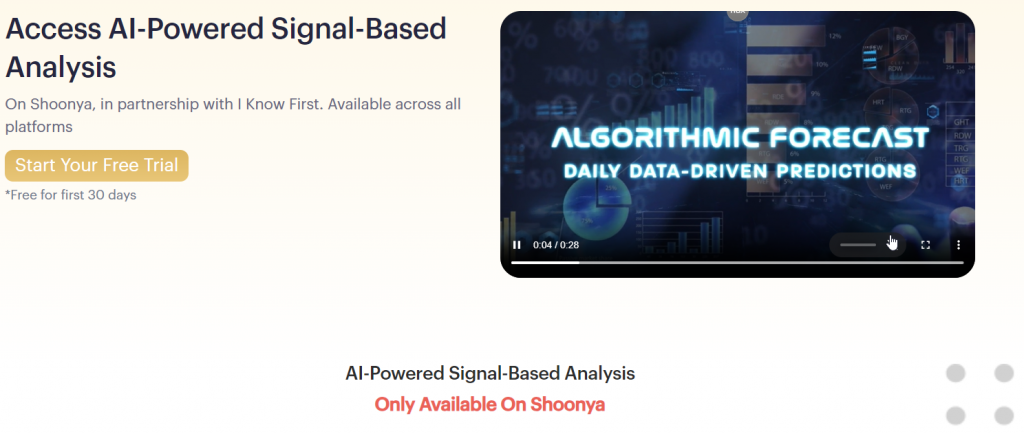Assessing the quality of the data and sources that are used by AI-driven stock prediction as well as trading platforms is critical for ensuring reliable and accurate insights. Insufficient quality data can result in inaccurate forecasts, financial losses and a lack of trust on the platform. Here are 10 of the best tips to help you evaluate the quality of data sources and their reliability.
1. Verify the source of the data
Check the origin of the data Make sure the data source is trustworthy and well-known data providers (e.g., Bloomberg, Reuters, Morningstar, or exchanges such as NYSE, NASDAQ).
Transparency: The platform needs to clearly disclose its data sources and keep them updated regularly.
Avoid dependency on a single source The most reliable platforms typically aggregate data from multiple sources in order to eliminate the chance of biases.
2. Assess Data Freshness
Real-time as opposed to. Delayed Data: Find out whether the platform offers actual-time data or delaying information. Real-time data can be crucial to trade in active fashion. Data that is delayed is adequate for long-term analyses.
Update frequency: Check when the information is updated.
Historical data accuracy: Ensure historical data is consistent and free of gaps or anomalies.
3. Evaluate Data Completeness
Find missing data.
Coverage. Make sure your platform includes a variety of markets, stocks, and indices that are relevant to your strategy of trading.
Corporate actions: Verify that the platform contains stock splits (dividends) as well as mergers and other corporate actions.
4. Test Data Accuracy
Cross-verify data: Compare the platform's data with those from other trustworthy sources to ensure that the data is consistent.
Look for mistakes by looking at excessive financial data or outliers.
Backtesting. Make use of old data to test trading strategy to see if it matches expectations.
5. Assess the Data Granularity
Level of detail: Ensure the platform offers granular data like intraday prices and volumes bid-ask spreads, as well as order book depth.
Financial metrics: Make sure the platform is able to provide detailed financial statements such as the balance sheet, income statement and cash flow. Also, make sure it has key ratios such as P/E (P/B), ROE (return on equity) and so on. ).
6. Clean up and processing of data
Data normalization: Ensure the platform normalizes the data (e.g. and adjusting for dividends, splits) to ensure that the data remains consistent.
Outlier handling: Check the way in which the platform handles outliers and anomalies in the data.
Missing data imputation Verify that your platform uses reliable methods for filling in the missing data.
7. Evaluation of Data Consistency
Aligning data with the correct time zone. To prevent discrepancies, ensure that all data is synced with each other.
Format consistency: Ensure that the information has been presented consistently (e.g. currency, units).
Cross-market consistency: Verify data Harmonization across various markets or exchanges.
8. Determine the relevancy of data
Relevance for trading strategies - Make sure that the data matches your trading style (e.g. quantitative modeling or quantitative analysis, or technical analysis).
Selecting Features: Check if the platform provides relevant features, such as sentiment analysis, economic indicators as well as news data which will improve the accuracy of forecasts.
Verify the security and integrity of data
Data encryption: Make sure whether the platform uses encryption to safeguard data while it is stored and transmitted.
Tamper proofing: Make sure that the information on the platform isn't being altered.
Compliance: Check to see whether the platform is in compliance with laws regarding data protection.
10. The Transparency Model of AI Platform is Tested
Explainability - Make sure the platform gives you insights into the way in which the AI model uses the data to make predictions.
Verify that bias detection is present. The platform should actively detect and correct any biases that may exist within the model or in the data.
Performance metrics - Examine the performance of the platform and performance indicators (e.g. accuracy, recall and precision) to assess the accuracy of their predictions.
Bonus Tips
Reputation and reviews of users Check out the user feedback and reviews to assess the reliability of the platform and data quality.
Trial period: Try the platform for free to check out how it functions and what features are offered before committing.
Customer support: Ensure the platform offers robust customer support for issues with data.
These suggestions will allow you to better evaluate the quality of data and the sources utilized by AI stock prediction platforms. This will allow you to make more informed trading decisions. Read the top investing ai examples for more recommendations including ai trading platform, copyright ai bot, ai investment platform, best ai trading app, best ai for trading, best free copyright trading bot, ai trading platform, best ai stocks, best ai stocks to invest in, best ai trading app and more.

Top 10 Tips To Assess The Scaleability Ai Stock Predicting/Analyzing Trading Platforms
To ensure AI-driven stock trading and prediction platforms can be scaled and scalable, they need to be able to handle the growing amount of data and the complexity in markets, and also customer demands. These are the top 10 tips to determine scalability
1. Evaluate Data Handling Capacity
Tip: Verify that the platform has the capacity to process and analyze huge data sets.
Why: Scalable platforms must handle growing data volumes without compromising performance.
2. Test Real-Time Processing Capabilities
See if your platform can handle real-time streams of data including live stock quotes, or breaking news.
Why: Real-time analysis is critical in trading decisions, and delays can lead to missing opportunities.
3. Check Cloud Infrastructure for Elasticity
Tip - Determine if a platform makes use of cloud-based infrastructure, e.g. AWS or Google Cloud.
Why cloud platforms are so popular: They provide elasticity, allowing the system to scale up or down based on demand.
4. Evaluate Algorithm Efficiency
Tip: Check the computational efficiency and the accuracy of AI models to make predictions.
Why: Complex algorithms are resource-intensive. Therefore optimizing them will aid in scaling.
5. Learn about Parallel Processing and Distributed Computer Systems.
TIP: Make sure to check whether the platform is using frameworks for parallel processing or distributed computing frameworks.
What are they: These technologies speed up the processing of data and allow for analysis across multiple nodes.
Examine API Integration, and Interoperability
Tip : Make sure the platform is compatible with other APIs, like market data providers and brokerage APIs.
The reason is that seamless integration allows the platform to be adapted to new trading environments and data sources.
7. Analyze User Load Handling
You can simulate the high users and see how the platform reacts.
The reason: A platform that is scalable must be able to maintain its performance when the number of users increases.
8. Examine the model's retraining capabilities and adaptability
Tip: Assess how frequently and efficiently the AI models are retrained with new data.
Why? Markets are constantly changing, and models have to adapt quickly in order to stay accurate.
9. Examine for fault tolerance and Redundancy
Tip: Check that the platform has failover features, and also has redundancy in the event of software or hardware malfunctions.
Why is downtime so costly for trading. Fault tolerance is therefore essential to scalability.
10. Monitor Cost Efficiency
Tip: Evaluate the cost of expanding the platform, such as cloud resources, data storage and computing power.
The reason: Scalability should not be at the expense of insufferable costs. It is therefore important to find a balance between performance and cost.
Bonus Tip Future Proofing
Check that the platform has been built to take advantage of new technologies (e.g., quantum computing, advanced NLP) and be able to adjust to regulatory changes.
By focusing your attention on these aspects and focusing on these factors, you can evaluate the scale of AI prediction as well as trading platforms. This guarantees that they are robust, efficient, and also well-equipped for future growth. Check out the most popular advice about ai investing for site tips including ai stock market, best ai stock, ai coin price prediction, ai stock market, ai investment stock, trading ai, ai for copyright trading, ai investment platform, chart ai for trading, ai copyright trading bot and more.
